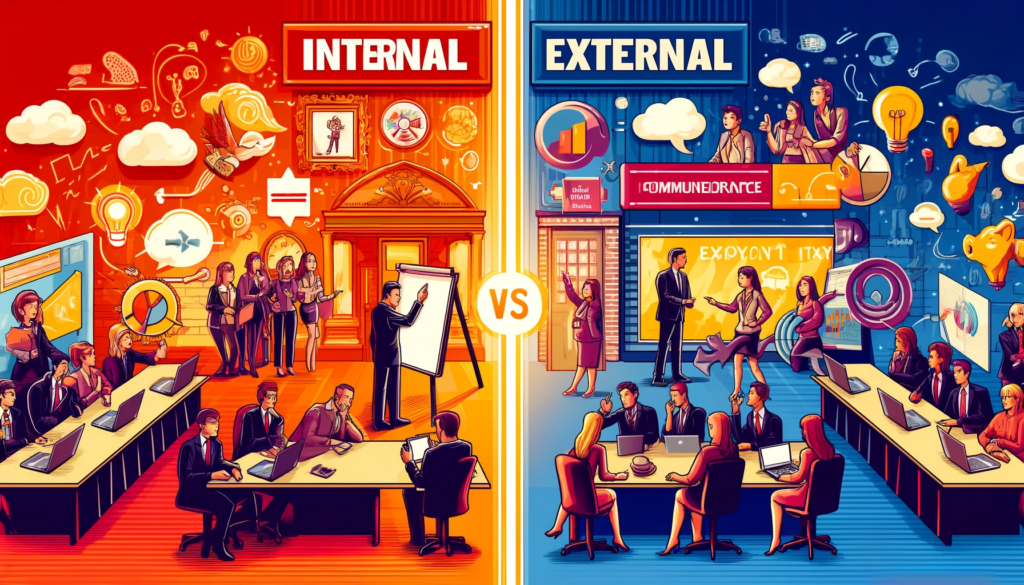Internal communication is all about fostering collaboration and trust within your company. It’s used for everything from sharing ideas to problem-solving. External communication, on the other hand, targets audiences outside your organization like customers or investors, building credibility and marketing your products. While internal communication often has a casual tone, external communication typically remains formal. Every message you send needs to fit its audience and purpose. Understanding these differences can streamline your communication process. Now, wouldn’t you like to know more about strategies for enhancing both internal and external communication?
Introduction to Internal and External Communication
Let’s dive into the world of business communication, beginning with the fundamental concepts of internal and external communication.
Recognizing the distinction between internal vs external communication is crucial. Internal communication refers to the dialogue within an organization. This includes the sharing of information, ideas, and company values among employees. The main goal here is internal alignment, ensuring everyone is on the same page. Various internal communication channels like meetings, emails, or internal social media platforms are used to accomplish this.
On the other hand, external comms involve interactions with the external environment, such as customers, suppliers, or investors. This type of communication aims to promote the company’s brand and values, attract new business, and maintain relationships with existing stakeholders. An effective external communication strategy uses different forms of communication from press releases to social media posts.
Both internal and external audiences are key in these processes. The communication tools used can differ based on the audience and the message. Your internal efforts are crucial in shaping your external image.
Understanding these concepts can significantly enhance your business communication strategy.
Defining Internal Communication
Let’s turn our attention to defining internal communication.
You’ll find it’s the heart of any organization, facilitating information flow among its members.
We’ll look at its purpose, various channels used, and provide some examples to illustrate it in action.
Purpose of Internal Communication
Diving into the purpose of internal communication, it’s essential to understand that it serves to foster collaboration, build relationships, and ensure all employees are aligned with the company’s mission and objectives. When comparing internal vs external communications, the internal communication focuses primarily on the needs of the internal stakeholders – your employees.
The main aim of internal communication is fostering collaboration. It provides a platform for employees to share ideas, solve problems, and work towards common goals. This, in turn, promotes a harmonious work environment, crucial for productivity and innovation.
Equally important is building relationships. Internal communication aids in creating an open and transparent environment where everyone feels valued and heard. It encourages conversations, builds trust, and strengthens bonds among employees.
Lastly, ensuring alignment is a vital function of internal communication. It ensures everyone understands and works towards achieving the company’s mission. This aspect of communication is often facilitated using various internal communication tools that help distribute mission-critical information effectively and efficiently.
Channels of Internal Communication
Having established the importance of internal communication in fostering collaboration, building relationships, and ensuring alignment, it’s now time to explore the various channels that facilitate this process within an organization.
Internal communication tools are diverse and varied. They range from formal internal communication channels, like internal memos and meetings, to more informal methods, such as internal messaging or casual conversations. Your internal communications teams use these tools to keep internal stakeholders informed and aligned with the organization’s goals.
Internal memos, for instance, often convey important news or updates, while meetings serve as a platform for discussion and decision-making. On the other hand, internal messaging platforms allow for quick, real-time communication among teams.
It’s important to have a balanced mix of formal and informal internal communication. While formal communication ensures everyone is on the same page, informal communication fosters a sense of camaraderie and openness.
Your internal communication strategy should strive to utilize these channels effectively, ensuring that your internal communication aims are met. From fostering collaboration to creating a sense of unity, the right blend of internal communication channels can make a significant difference.
Examples of Internal Communication
You encounter numerous examples of internal communication in your daily work life, whether it’s a quick project update via email, a comprehensive team meeting, or a well-crafted internal newsletter. These communication methods are critical for ensuring smooth operations within any organization.
Project updates are a form of formal communication that keeps team members informed about the progress of ongoing tasks. You’ll often receive these via communication tools such as email or project management software.
Similarly, team meetings are a more interactive form of communication and collaboration, enabling discussions, brainstorming, and problem-solving in real-time.
Internal newsletters, on the other hand, serve as a more comprehensive communication tool. They provide a broader view of the organization’s activities, achievements, and future plans. They’re a way of keeping internal audiences informed and engaged.
Informal communication also plays a significant role in internal communication. Casual conversations, quick check-ins, and water cooler chats are all forms of this. While less structured, they contribute to a sense of camaraderie and team unity.
Defining External Communication
Now, let’s turn your attention to external communication. This involves conveying information from your organization to those outside it.
We’ll explore its purpose, the channels used for it, and some practical examples to give you a clear understanding.
Purpose of External Communication
External communication serves several key objectives, including building your company’s credibility, marketing your products or services, and maintaining a positive public image. It’s a critical component of your business’s communication strategies, both internal and external.
With external communication, you’re reaching out to your internal and external stakeholders, such as clients, potential customers, investors, and the general public. A robust external communication strategy can help build a good image of your business, establish trust, and foster fruitful relationships with your stakeholders.
External communication includes activities like press releases, advertising, public relations, and customer interactions. These efforts aim to promote your products or services, address customer inquiries, and disseminate crucial information about your company.
A well-executed external communication strategy can enhance your brand’s profile and reputation, making it more appealing to potential clients and partners.
| Key Purpose of External Communication | Examples |
|---|---|
| Building credibility | Sharing achievements, awards, testimonials |
| Marketing products or services | Advertising, sales promotions |
| Maintaining a positive public image | Managing PR, community involvement |
| Engaging with stakeholders | Regular updates, newsletters |
| Informing public and stakeholders | Press releases, public statements |
Channels of External Communication
When it comes to reaching audiences outside your organization, several channels of external communication come into play, including social media, press releases, advertisements, and public relations campaigns. These external communication channels are crucial in communicating your business units’ objectives, goals, and achievements to the external world.
Understanding the key differences between internal and external communication is vital for your organization. While good internal communication maintains harmony among different departments within your organization, external communications need to be designed to reach a broader audience. They convey your brand message and values, making them fundamental for your business’s reputation and growth.
Let’s explore some of the most common external communication channels:
- Social Media: Platforms like Facebook, Twitter, LinkedIn are used to reach customers, investors, and other stakeholders.
- Press Releases: These are official statements issued to newspapers giving information on a particular matter.
- Advertisements: These are the messages paid for by those who send them and are intended to inform or influence people who receive them.
- Public Relations Campaigns: These are strategically designed to improve the public image of your company.
Examples of External Communication
Moving from the channels to specific examples, let’s look at how you might encounter external communication in everyday business. Unlike internal communication, which focuses on dialogue between employees, external communication involves an entity from the external environment. Press releases, customer newsletters, and social media updates are prime examples of external communication.
These external messages are designed to reach customers, shareholders, regulatory authorities, and the general public. They’re more than just words, they’re a tool for conveying your company’s brand, values, and objectives.
The main goal of external communication is to build a positive perception of your company and its products or services, attracting new customers and retaining existing ones.
External communications are crucial for maintaining a strong relationship with your audience and stakeholders. Whether it’s through formal press releases or informal external tweets, communication is happening with both employees and external entities.
It’s this blend of internal vs external communication that keeps a business thriving. So, next time you draft a customer newsletter or post a company update on social media, remember – you’re not just sending a message, you’re shaping the perception of your brand.
Key Differences Between Internal and External Communication
Let’s now examine the key differences between internal and external communication.
You’ll find that purpose, audience, and formality significantly vary between the two.
Understanding these contrasts will help you decide the most effective strategy for each type of communication.
Purpose and Goals
Understanding the distinct purposes and goals of internal and external communication can greatly improve your business’ effectiveness. Internal communication allows for the sharing of information, ideas, and feelings within the organization. It’s about keeping everyone within the company connected with a single communications thread. It plays a vital role in decision-making processes and can be formal or informal.
Internal communication goals tend to focus on:
- Promoting a strong company culture and unity
- Facilitating information sharing and collaboration
- Encouraging employee engagement
- Driving employees towards common business goals
External communication involves the exchange of information between the organization and the outside world. This includes customers, competitors, suppliers, regulators, and the general public.
External communication goals often include:
- Enhancing the company’s reputation and brand
- Building relationships with customers and stakeholders
- Promoting products or services
- Providing important company news and updates
To improve internal and external comms, your internal communications need to work in harmony with your external messages. Strong internal communications foster a unified workforce, who in turn, present a consistent and cohesive image to the world. This is vital in building trust with your external stakeholders. These two types of communication aren’t separate entities, but interconnected aspects of your overall communication strategy.
Audience and Participants
While you’ve been focusing on the purpose and goals of internal and external communication, it’s equally important to recognize the different audiences and participants these types of communication cater to. Internal communication primarily targets the company’s internal audiences, encompassing various business units, departments, and teams. The internal communications teams employ a range of internal communications tools to ensure effective communication within the organization.
On the other hand, external communication is directed towards individuals and entities outside the organization. The audiences can include clients, customers, potential investors, and the general public. While internal communication is said to foster a shared understanding among employees, external communication aims to build the company’s reputation and foster strong relationships with the external stakeholders.
In terms of participants, internal and external communicators play distinctive roles. Internal communicators are focused on promoting cooperation and unity among different business units. External communicators, on the other hand, concentrate on presenting a positive image of the company to the public.
Understanding the key differences between internal vs external communication aids in tailoring messages to the correct audience, ensuring effective communication.
Formality and Tone
Differences in formality and tone significantly mark the distinction between internal and external communication. As your communication teams interact with various business units, they must adjust their language to suit the audience.
Internal communication often adopts a more casual tone, allowing for openness and camaraderie among internal audiences. However, in external communication, the tone and formality level usually increase to maintain professionalism and a positive corporate image.
Bear in mind these key differences:
- Internal communication often uses industry-specific jargon that all employees understand.
- External communication requires simplicity and clarity to reach a broader audience.
- The formality of internal communication may vary depending on the company culture, while external communication typically remains formal and professional.
- Frequency may be higher in internal communication since it goes hand-in-hand with daily operations, whereas external communication often comes in planned, strategic bursts.
Understanding these differences can help create a unified communication strategy. Your internal and external communication must work hand-in-hand, ensuring all messages align with your company’s goals and values.
Benefits of Effective Internal and External Communication
You’ll find that effective internal and external communication can offer substantial benefits to your organization.
With strong internal communication, you’re fostering a well-informed, collaborative, and motivated workforce.
Meanwhile, external communication allows you to build trust with your customers, enhance your reputation, and ultimately drive business growth.
Benefits of Internal Communication
Effective internal communication can significantly boost your organization’s morale, foster better team collaboration, and ramp up productivity levels. It’s a crucial tool to align various business units and departments towards achieving your company’s strategic goals.
- It creates a unified communication platform for the entire organization, ensuring everyone is on the same page.
- It enhances employee morale as internal audiences feel valued and informed, leading to increased loyalty and job satisfaction.
- It fosters team collaboration by promoting the exchange of ideas and information, thus sparking creativity and innovation.
- It drives increased productivity as well-informed employees can perform their duties more efficiently, reducing errors and improving service delivery.
Benefits of External Communication
Just as internal communication has its benefits, external communication also plays a pivotal role in your company’s success, helping to build your brand reputation, attract new customers, and maintain positive relationships with stakeholders.
External communication strategies allow you to reach out to external audiences, such as customers, investors, and partners. Utilizing a variety of communication channels, from social media to press releases, you can ensure your message gets across. The feedback loop that comes from external communication is invaluable, providing insights that can shape your brand advocacy and crisis management strategies.
| Benefits | Communication Channels | Examples |
|---|---|---|
| Brand Reputation | Press Releases, Social Media | Sharing corporate achievements |
| Customer Attraction | Websites, Email Campaigns | Promoting new products or services |
| Stakeholder Relationship | Meetings, Reports | Regular updates on company performance |
Unified communication, combining both internal and external channels, can provide a more comprehensive approach. Maintaining a balance between internal and external communication is key. Your internal audiences need to be as well-informed as your external ones. By doing so, you’re creating a strong, cohesive message that resonates both inside and outside your company.
Strategies for Improving Communication
You’re likely eager to improve your company’s communication. Let’s explore strategies that can enhance internal communication, ensuring your team is aligned and informed.
Then, we’ll expand the discussion to strengthening external communication, which can boost your brand’s reputation and customer relationships.
Enhancing Internal Communication
To enhance internal communication in your organization, start by fostering an environment that encourages open feedback. This will allow various business units to express their views and contribute to the company’s decisions. It’s vital to remember that internal communication goes hand-in-hand with external communication. They’re two sides of the same coin and function best when coordinated effectively.
Here are some strategies to improve your internal communication:
- Utilize Unified Communications: This integrates real-time communication services like instant messaging and video conferencing, facilitating better information sharing among internal teams.
- Use Multiple Communication Channels: Don’t rely on email alone. Use different communication channels like intranet, social media, and face-to-face meetings to reach your internal audiences.
- Promote Information Sharing: Encourage employees to share their knowledge and insights. This can lead to innovative ideas and better decision-making.
- Regular Updates: Keep your team informed about what’s happening in the company. Regular updates help employees feel involved and valued.
Strengthening External Communication
While enhancing internal communication keeps your team connected, it’s equally important to bolster your external communication strategies for maintaining a strong relationship with customers, clients, and stakeholders. You can achieve this by aligning communication across various business units to ensure consistency in your messaging. This not only strengthens your brand but also instills trust among your external stakeholders.
Personalizing your communication, whether through emails or social media, makes your external stakeholders feel valued and appreciated. It’s also vital to uphold transparency in information sharing. Whether it’s news about your company or updates about your products or services, be honest and open. This builds and maintains credibility, further fortifying your relationships with external audiences.
Remember, regular updates to your external stakeholders are key. They keep everyone informed about your company’s developments and initiatives. This consistent communication helps manage expectations and also provides a platform for feedback, allowing you to make necessary adjustments in your strategies.
In essence, strengthening external communication is about fostering relationships through communication consistency, transparency, and regular updates. It requires a strategic alignment with your internal communication, creating a harmonious information sharing environment within and outside your organization.
Integrating Internal and External Communication
In ensuring a cohesive and effective communication strategy across your organization, integrating both internal and external communication plays a vital role. This integration bridges the gap between what’s said to be internal, i.e., the information exchanged within various business units and departments, and what’s reaching your external stakeholders.
This balance between the two forms of communication is essential as sometimes, internal communications teams don’t accurately reflect what’s actually happening inside your company to the outside world.
Here’s why you should consider integrating these two forms of communication:
- Enhanced Transparency: When your company’s internal messages match what’s being shared externally, it fosters trust and authenticity.
- Unified Messaging: Ensures all business units are on the same page, promoting a consistent company narrative.
- Increased Employee Engagement: Employees feel more engaged when they’re aware of what’s being communicated to the outside world.
- Better Crisis Management: In times of crisis, having a unified communication strategy can significantly improve how your organization responds and recovers.


